By: Sonja Perić, senior curator
Research into the Neolithic of central Pomoravlje is the goal of the project “Permanent Archaeological Workshop – Central Pomoravlje in the Neolithization of Southeast Europe”, which has been carried out for the third decade by the Archaeological Institute in Belgrade, under the leadership of Slaviša Perić phd, and under the auspices of the Ministry of Culture of the Republic of Serbia. The project includes an insight into archaeological material of the museum in the territory of central Pomoravlje, archaeological prospecting, geomagnetic surveys and archaeological excavations of sites of the older, middle and younger Neolithic, proto-Starčevo, Starčevo and Vinča cultures in this territory.
This year, the implementation of activities continued at one of the most important Neolithic sites in our country, at the Slatina site – Turkish Fountain in Drenovac. So far, for about two decades, on this site, which occupies an area of several tens of hectares on both sides of the highway Belgrade – Niš, over 2,500 m² of archaeological probes have been explored and about 20 Neolithic houses from the youngest phase of the Vinča culture (4600 – 4500 BC). The cultural layer on the site is more than 6 m thick, and in the deepest layers, the oldest residential horizons belong to the Starčevo culture. Systematic research of the site in Drenovac began in 2012 with the prospecting of the terrain and the collection of surface finds, which provided the first guidelines for further work. On two-thirds of the locality, geomagnetic surveying was carried out, which showed the existence of over 600 anomalies, the existence of over 600 objects, the majority of which are houses, but also pits, waste pits, as well as cult objects.
The team conducting research this year consists of experts from the Archaeological Institute in Belgrade, led by Slaviša Perić phd, Đurđa Obradović phd, Olga Bajčev phd, permanent expert associates Vesna Popović, Aleksandar Čvorović, Dajana Matović, as well as Sonja Perić, curator of the Regional Museum of Jagodina, and students of the Department of History and Archeology of the Faculty of Philosophy of the University of East Sarajevo, with the help of locally hired workers.
Interested in the activities of the Archaeological Institute and the engagement of the staff of the Regional Museum of Jagodina, Dušan Marković, acting director of the Museum, visited the team in the field, in order to get a closer picture of the actual archaeological excavations, field work and archaeological wealth that central Pomoravnia has. After visiting the archaeological probe that has been excavated this and in recent years, on the western side of the highway, Dušan Marković, accompanied by dr Slaviša Perić, also visited the exhibition balloon with covered objects of Vinča culture, houses with inventory, on the eastern side of the highway, which is only part of the future scientific – research and tourist complex at the Slatina-Turska česma site. Marković expressed his delight for the results of research in Drenovac so far, the enthusiasm, dedication and love for the work of archaeologists working in the field and the archaeological wealth of our region, in the hope that the Archaeological Institute will renew the cooperation with the Regional Museum of Jagodina, which was at the beginning of the 21st century successful and fruitful and continue research on the territory of Jagodina.
As a prelude to the continuation of the active cooperation between the Institute and the Museum on the research of the Neolithic of the Jagodina territory, an exhibition has been announced that will present the results of the excavations in 2007 in Međureč, at the Dunjićki šljivari site, which would be followed by the continuation of the research of this site, as well as other significant sites in central Pomoravlje.





